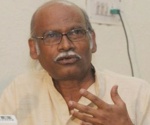Subhas Chandra Pattanayak
Is it possible that the Sun sets on daybreak?
Yes. Because, Nirad Mohapatra breathed his last at 6 AM.
When Orissa was to receive the first rays of the Sun, she had no idea that the Sun that had kept her sky of creativity illuminated was setting in the western part of the country in Mumbai.
He was under treatment in a Navy Mumbai Hospital where surgery had dragged him into complications.
Mumbai shall have his pyre in her lap.
The legendary film director whose first feature film Maya Miriga (1984) that had added glory to India’s international image as producer of top quality films, was adjudged the Best Third World Film at International Film Festival at Heidelberg besides many other international and national accolades, had made it a film of speaking peculiarity of Orissa’s family values and vulnerabilities.
 Whenever I had visited him, I had seen in him a sage of knowledge on human nature and behavior in social context. A man of extraordinary erudition and ability of interpretation, he had made tremendous contributions to Film and Television Institute of India (FTII) Pune as a student as well as a theoretician member of its faculty.
Whenever I had visited him, I had seen in him a sage of knowledge on human nature and behavior in social context. A man of extraordinary erudition and ability of interpretation, he had made tremendous contributions to Film and Television Institute of India (FTII) Pune as a student as well as a theoretician member of its faculty.
If cinema is religion, he was master of its theology.
His endeavor to popularize good cinema had made him form a unique platform for the purpose that was known and famous as Cinexstacy. The aptness of the name explains its aim. It was not only a platform for popularization of good cinema, but also a provider of opportunities for cinema scholars to watch and interact on world famous classics.
The world knows how many landmark documentaries he has made.
The world will remember him for the pattern he had in directing the documentaries.
His cultural documentaries such as Dhauligiri Shanti Stupa (1974), Chhau Dance of Mayurbhanja (1985), Pata Painting (1986), Maestros of Odfissi (1995) are as masterpieces as are his ecological documentaries like The vanishing Frontier (1989), and Chilika – A fragile Eco-system (2002). If The Story of Cement (1976) was an industrial documentary, the documentary on polio – A New Horizon – was a touching tribute to the physically challenged brave members of society in context of State’s awareness to their need. He has many more documentaries on behalf of various departments/institutes. But in all of them, the uniquely distinct Niradian touch will continue to attract cinema producers, directors and scholars desirous in knowing how best a documentary could be made to deliver the desired message.
As I share the sad news that on daybreak today, the Sun of Orissa’s cinematic creativity set in the western horizon of India in Mumbai, I stand in solemn silence in his memory.
